Portrait of Whitehill
Two centuries of mining are behind the village of Rosewell and the present Whitehill pit, set among the trout burns and countryside of Midlothian.
Story by Sid Chaplin, Photographs by Hayward Smead, "Coal", volume 7, August 1953
In 1770 a group of miners at Whitehill colliery. Midlothian, near Edinburgh, broke their bonds. Serfs by law, as were all Scottish miners in those days, they were the property of the coalmaster. If the pit was sold they were part and parcel of the price. Even sons and daughters were bound to the pit and its owner. In return the coalmaster was obliged to maintain his serf in sickness or old age, even to the provision of a coffin at his funeral. Not prepared to wait for their coffins the Whitehill serfs deserted, but were traced to Glasgow and sent back under escort.
Before leaving Glasgow they were given a dram of whisky each to ‘put them in a good humour.’ To their disgust the cost of the whisky was added to the bill of expenditure (£18) which they had to repay in weekly instalments.
These men probably worked at the ‘Splent Coal Pit’ .of which a plan dated 1772 still survives. But long before that date there were pits at Whitehill, and many others were to follow. Plans made in 1826 show that there were numbers of shallow pits and workings (some with stairs so that the coal could be man- or woman-handled to the surface).
So the present shaft and its tandem pulleys overlooking the little village of Rosewell is just the latest of a long line of Whitehills. Both pit and village have the dignity of a long tradition and have grown to mellow with a land of trout burns, market gardens and great houses. Most of the buildings and a greater part of the cottages in the village (there are none of the usual tenements) are built of bricks made at the colliery from blaes brought out of the pit. Each of the 400 N.C.B. houses has a bath.
‘We have everything here that the heart can desire,’ said checkweighman Ben McKay as he pointed out the landmarks: Whitehill Mansion, enfolded in trees, once the home of the lairds who had so much to do with the early history of Rosewell and its pit; Pentland and Moorfoot Hills and the rolling, pleasantly-timbered lowland countryside to the south. ‘We’re within easy reach of border, sea and city. We’ve good walking, good fishing - and good neighbours.’
Rosewell produces pigeon-fanciers, anglers and keen gardeners. A fine welfare hall, which was built in 1917, partly from the profits of the Miners’ Tavern, a public house run under the Gothenburgh system whereby all profits are directed to village organisations, is the centre of social activities. Boxing, bowling, and drama clubs have all won Divisional honours at one time or another. The fine dance and concert hall is in demand for many Midlothian events. In it there are billiards, games and reading rooms, a fine reference library, and children’s welfare and dental clinics.
At the pit weigh-cabin Ben McKay keeps his ‘encyclopaedia’, an old account book in which he records all the major events of pit and village, as well as local and national disputes and agreements. One entry indicates a social climate somewhat different from that of 1770: ‘Christmas 1952: A present (value 12s 6d), from welfare committee to every official and workman at the pit consisting of two towels, shortbread cake and currant bun’.
Outside the weigh-cabin pass the little hutches bringing the coal from the one seam worked at Whitehill – the Great Coal Seam, which probably derives its name from its six feet thickness. The shaft (286 feet deep) is divided by a partition, with one cage working in each compartment.
Production is concentrated into one district of two longwall faces and a development unit. There is also a training face. Weekly output averages 4,000 tons for the five day week, with a saleable O.M.S. of 27 cwts.
Part and parcel of the pit is the brickworks, awarded a prize last year as the best-kept brickworks in Scotland. The plant produces some 58,000 bricks daily. They are ‘baked’ in chambers holding 11,000 bricks at a time. Fuel costs are low. Five tons of coal were used last July to fire the chambers. Since then the bricks have baked themselves on the gases they produce.
Now Whitehill bricks are being used on the latest development - a new drift mine and screens, expected to start in 1954. Coal will then be loaded at an underground central loading point, into three-tons-capacity mine cars drawn by battery locomotives to the mine bottom, then to the surface by direct rope haulage. These improvements are expected to raise O.M.S. to 35 cwts. Later, a continuation of the new mine will develop the hitherto unworked portions of Splint Seam Coal.
Portrait of Whitehill
Two centuries of mining are behind the village of Rosewell and the present Whitehill pit, set among the trout burns and countryside of Midlothian
Story by Sid Chaplin, Photographs by Hayward Smead
In 1770 a group of miners at Whitehill colliery. Midlothian, near Edinburgh, broke their bonds. Serfs by law, as were all Scottish miners in those days, they were the property of the coalmaster. If the pit was sold they were part and parcel of the price. Even sons and daughters were bound to the pit and its owner. In return the coalmaster was obliged to maintain his serf in sickness or old age, even to the provision of a coffin at his funeral. Not prepared to wait for their coffins the Whitehill serfs deserted, but were traced to Glasgow and sent back under escort.
Before leaving Glasgow they were given a dram of whisky each to ‘put them in a good humour.’ To their disgust the cost of the whisky was added to the bill of expenditure (£18) which they had to repay in weekly instalments.
These men probably worked at the ‘Splent Coal Pit’ .of which a plan dated 1772 still survives. But long before that date there were pits at Whitehill, and many others were to follow. Plans made in 1826 show that there were numbers of shallow pits and workings (some with stairs so that the coal could be man- or woman-handled to the surface).
So the present shaft and its tandem pulleys overlooking the little village of Rosewell is just the latest of a long line of Whitehills. Both pit and village have the dignity of a long tradition and have grown to mellow with a land of trout burns, market gardens and great houses. Most of the buildings and a greater part of the cottages in the village (there are none of the usual tenements) are built of bricks made at the colliery from blaes brought out of the pit. Each of the 400 N.C.B. houses has a bath.
‘We have everything here that the heart can desire,’ said checkweighman Ben McKay as he pointed out the landmarks: Whitehill Mansion, enfolded in trees, once the home of the lairds who had so much to do with the early history of Rosewell and its pit; Pentland and Moorfoot Hills and the rolling, pleasantly-timbered lowland countryside to the south. ‘We’re within easy reach of border, sea and city. We’ve good walking, good fishing - and good neighbours.’
Rosewell produces pigeon-fanciers, anglers and keen gardeners. A fine welfare hall, which was built in 1917, partly from the profits of the Miners’ Tavern, a public house run under the Gothenburgh system whereby all profits are directed to village organisations, is the centre of social activities. Boxing, bowling, and drama clubs have all won Divisional honours at one time or another. The fine dance and concert hall is in demand for many Midlothian events. In it there are billiards, games and reading rooms, a fine reference library, and children’s welfare and dental clinics.
At the pit weigh-cabin Ben McKay keeps his ‘encyclopaedia’, an old account book in which he records all the major events of pit and village, as well as local and national disputes and agreements. One entry indicates a social climate somewhat different from that of 1770: ‘Christmas 1952: A present (value 12s 6d), from welfare committee to every official and workman at the pit consisting of two towels, shortbread cake and currant bun’.
Outside the weigh-cabin pass the little hutches bringing the coal from the one seam worked at Whitehill – the Great Coal Seam, which probably derives its name from its six feet thickness. The shaft (286 feet deep) is divided by a partition, with one cage working in each compartment.
Production is concentrated into one district of two longwall faces and a development unit. There is also a training face. Weekly output averages 4,000 tons for the five day week, with a saleable O.M.S. of 27 cwts.
Part and parcel of the pit is the brickworks, awarded a prize last year as the best-kept brickworks in Scotland. The plant produces some 58,000 bricks daily. They are ‘baked’ in chambers holding 11,000 bricks at a time. Fuel costs are low. Five tons of coal were used last July to fire the chambers. Since then the bricks have baked themselves on the gases they produce.
Now Whitehill bricks are being used on the latest development - a new drift mine and screens, expected to start in 1954. Coal will then be loaded at an underground central loading point, into three-tons-capacity mine cars drawn by battery locomotives to the mine bottom, then to the surface by direct rope haulage. These improvements are expected to raise O.M.S. to 35 cwts. Later, a continuation of the new mine will develop the hitherto unworked portions of Splint Seam Coal.
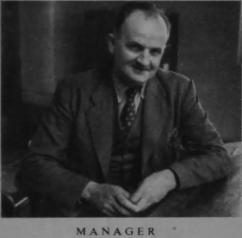 | Son of a West Lothians miner who is still working at the age of 73,
Leonard Thomson has been manager at Whitehill since 1951 . Starting at
Arniston (Emily) pit coalface with his father at 14, he later
transferred to Lingerwood where he tackled most jobs, becoming a fireman
and captain of the pit’s rescue team (winner of the Lothians Rescue
Competition 1937, ‘38 & ‘39). In 1939 he was put in charge of the
American machinery - Joy Loaders and shuttle cars - introduced there. At the request of the general manager of the Lothian Coal Company he studied at evening classes and the Heriot- Watt College, Edinburgh. A year after getting his 2nd class certificate he was sent to Whitehill (as assistant to the manager) to supervise the driving of the new mine. Appointed under-manager at Easthouses colliery, 1946. Won his 1st class certificate 1945. Appointed manager at Winton and Limeylands colliery, 1947. Three brothers are working at Lingerwood (one a supports economy officer, two mine-drivers): and three sisters are all married to miners. Has one daughter (11). Keen (when he can find time) ‘soccer fan’. |
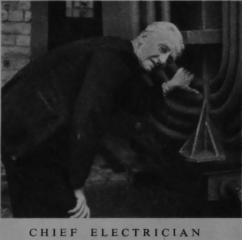 | Chief electrician at Whitehill, 56-year-old Alex Foster was born at Dunedin (South Island), New Zealand, son of a Scots emigrant miner who later returned (when Alex was a year old) to settle down at Rosewell. Father (now 92) is still hale and hearty. Alex is one of a family of nine, five sisters (all born in Scotland), four brothers (all born in New Zealand). One brother was killed (at Whitehill), another in France (1916). Other surviving brother owns two mines in Canada. Started at Whitehill as a pony-driver in 1910; later became an apprentice electrician. Served in the Royal Engineers (1915-19). Appointed chief electrical engineer for Whitehill and nearby Polton (now closed) in 1925. Three daughters and a son, latter in agricultural work. Sports: angling (player), soccer (spectator). |
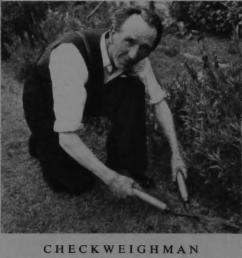 | Born in Edinburgh 46 years ago, checkweighman Ben McKay was adopted by a Whitehill miner and started underground as a pony-driver at 14. Has since done most jobs underground. Became an active member of his union branch at 16 and after coming into conflict with the management started a tour of Lothians pits, staying only a short while at each to gain a reputation as a militant trade unionist—and the sack. After three years with the Forestry Commission went to England ‘to learn geography through circumstances’. As a builder’s labourer in the East End he learned to appreciate the London docker. After a spell of roadmaking at Leatherhead, he returned to Scotland where a new manager at Whitehill gave him a start: ‘They say you’re a stormy petrel, but I’ll judge for myself’. Elected to the Midlothian County Council in 1936 (by an overwhelming majority, the first-ever Labour councillor for Rosewell) he helped to improve housing, lighting and sanitation; as chairman of the village Co-op he was responsible for merging it with St. Cuthbert’s Co-operative Society, biggest in South-East Scotland. Has been branch delegate 20 years. Opposed only once. A bachelor. Hobby: social progress. Strongly against Scottish cult of ancestor-worship - ‘Wallace and Bruce were buccaneers, not patriots’. Scottish Nationalism is, he says, a social red herring. Fond of music (Beethoven, Bach, Handel. Strauss, and folksongs). Most interesting experience: invited to dinner at Melville Castle to debate politics with Hon. Robert Melville, later killed during the Fall of France - ’A great gentleman who really deserved the title Honourable‘. One sister and a brother, latter a commissionaire at the Regal Cinema, Marble Arch, London. |
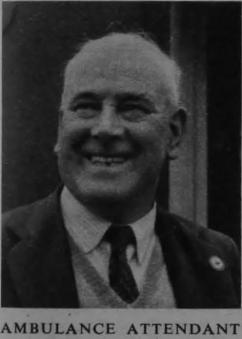 | Son of an agricultural worker, David Hay (57) spent his early years in Edinburgh. Left school at 14, became a railway clerk at Leith and Dalkeith. Life-long interest in first-aid began at 16, when members of Leith St. Andrews Association section gave him a 2s. 64. text book. At 26 went to Lady Victoria Pit, Newbattle, as a clerical worker. Three years later was transferred to Whitehill, where he was later appointed ambulance attendant (in addition to his duties as stores clerk). Last year, to his delight, colliery workmen converted an old storehouse into a spacious medical centre, fully equipped and with hot water and bath. Has had many experiences, the most moving, when a 16-year-old boy, a Catholic, was carried to the surface dying. Two of his workmates, both Protestants, asked to be with him, one held the dying boy’s hand whilst the other prayed.’ Most amusing: when a man was sent straight off to the hospital after a message saying his head had been crushed and he was spitting blood. In reality he had stumbled and bit his tongue. Keen ‘soccer‘ fan, is interested in the local Junior team of which he has been trainer and secretary. One son, an engineer, with the Cape Town gasworks, and a grandson born on his grandfather’s birthday. |
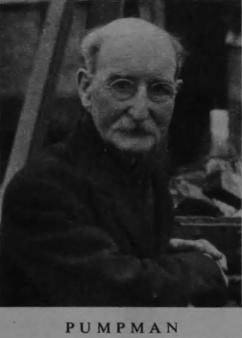 | Before settling down at Whitehill, 76-year-old Robert Kinlouch did a lot of ‘flitting’ about, Lanarkshire (where he started at Dixons No. 3 Pit, now closed) to Prestongrange just before the big strike of 1894. In the following year his father, a union committee man, was evicted during a pit strike. The family moved to Morristown colliery, Penicuik; then, after that pit closed, to Whitehill, where he worked 54 years out of a total of 63 underground. Hewing until 15 years ago he is now a pumpman, working six, sometimes seven, shifts weekly. A keen gardener he is known at all the local nurseries and market-gardens as a visitor, at flower-shows as a competitor with his favourites - roses and sweet peas. Has had a family of eight - five sons and three daughters. Two sons abroad, one in South Africa, in the gold-mines, another at Singapore, working for the Air Ministry. Another son runs a baker’s business in Southport. |
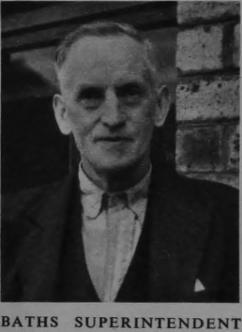 | Born at Rutherford, near Jedburgh on the Border, John Leslie (61 )first heard about mining from miners who spent their holidays harvesting on the Border farms. His father, a ploughman, moved to Whitehill and got a job at the colliery brickworks at 16s 10d a week, later becoming in turn repairer, power-station attendant, electrician and colliery chief electrician. John started work at 14, as a pony-driver in the brickworks. After a year went underground. Served with Medical Corps (1914-18), spending nearly a year in Arabia - in the T. E. Lawrence period - the rest in Italy, Greece and Palestine. Spent Christmas, 1917, at Jerusalem, celebrated with a double rum-ration and a bonfire made of an old railway wagon. After returning, worked only a month, then was laid off almost two years with malaria (malignant) recovering eventually to become a member (for seven years) of the pit rescue team. Became baths attendant in 1936, superintendent in 1946. Was a blood donor for six years, until he resigned on doctor’s orders. A keen angler in the Tweed and its tributaries (for brown trout) his record catch is 42 fish from one small burn; his biggest, a 4 1/2 lb. Loch Leven trout from a nearby reservoir. Two daughters, and a son now with the De Havilland Co., Sydney, Australia, after service in the Fleet Air Arm. |
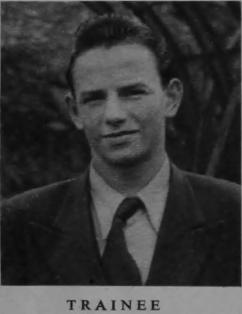 | Three years ago training officer Don Chambers escorted a party of secondary schoolboys underground. Among them was James Moffat, who decided then and there to make mining his career. Now 16, James has just completed his training course at Lingerwood colliery. He is keen on swimming, and wants to be a stripper at Whitehill. |